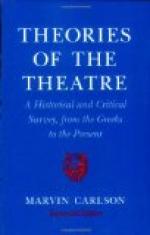At the first night of Mr. E.H. Sothern’s Hamlet, in the fall of 1900, I had just settled back in my chair to listen to the reading of the soliloquy on suicide, when a woman behind me whispered to her neighbor, “Oh look! There are two fireplaces in the room!” My attention was distracted, and the soliloquy was spoiled; but the fault lay with the stage-manager rather than with the woman who spoke the disconcerting words. If Mr. Sothern was to recite his soliloquy gazing dreamily into a fire in the centre of the room, the stage-manager should have known enough to remove the large fireplace on the right of the stage.
Mme. Sarah Bernhardt, when she acted Hamlet in London in 1899, introduced a novel and startling effect in the closet scene between the hero and his mother. On the wall, as usual, hung the counterfeit presentments of two brothers; and when the time came for the ghost of buried Denmark to appear, he was suddenly seen standing luminous in the picture-frame which had contained his portrait. The effect was so unexpected that the audience could look at nothing else, and thus Hamlet and the queen failed to get their proper measure of attention.
These two instances show that the necessity of economising the attention of an audience is just as important to the stage-manager as it is to the dramatist and the actor. In the main, it may be said that any unexpected innovation, any device of stage-management that is by its nature startling, should be avoided in the crucial situations of a play. Professor Brander Matthews has given an interesting illustration of this principle in his essay on The Art of the Stage-Manager, which is included in his volume entitled Inquiries and Opinions. He says:
The stage-manager must ever be on his guard against the danger of sacrificing the major to the minor, and of letting some little effect of slight value in itself interfere with the true interest of the play as a whole. At the first performance of Mr. Bronson Howard’s Shenandoah, the opening act of which ends with the firing of the shot on Sumter, there was a wide window at the back of the set, so that the spectators could see the curving flight of the bomb and its final explosion above the doomed fort. The scenic marvel had cost time and money to devise; but it was never visible after the first performance, because it drew attention to itself, as a mechanical effect, and so took off the minds of the audience from the Northern lover and the Southern girl, the Southern lover and the Northern girl, whose loves were suddenly sundered by the bursting of that fatal shell. At the second performance, the spectators did not see the shot, they only heard the dread report; and they were free to let their sympathy go forth to the young couples.
Nowadays, perhaps, when the theatre-going public is more used to elaborate mechanism on the stage, this effect might be attempted without danger. It was owing to its novelty at the time that the device disrupted the attention of the spectators.




